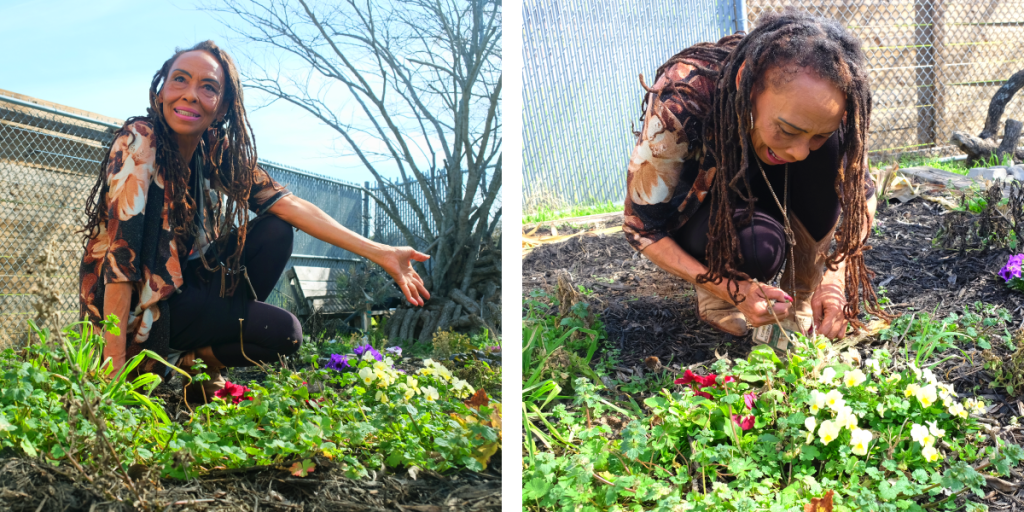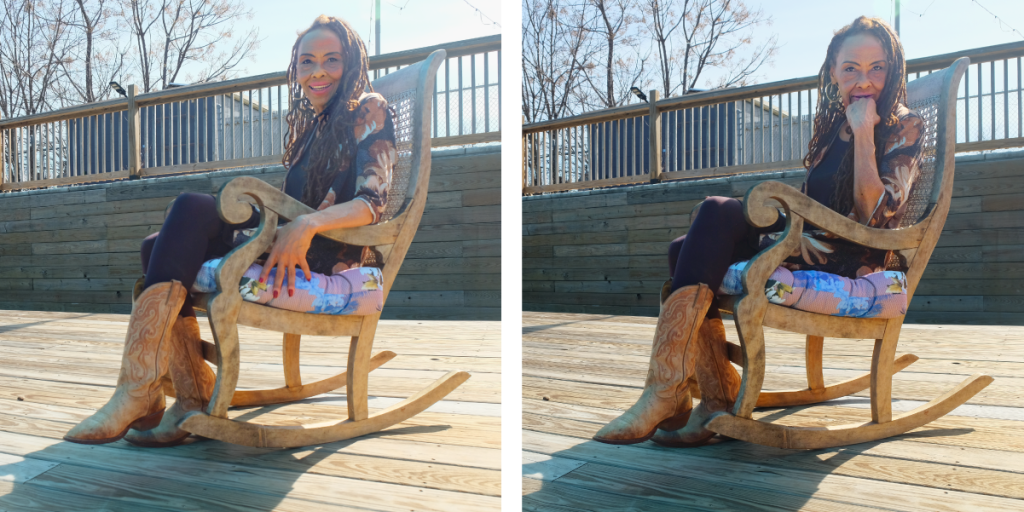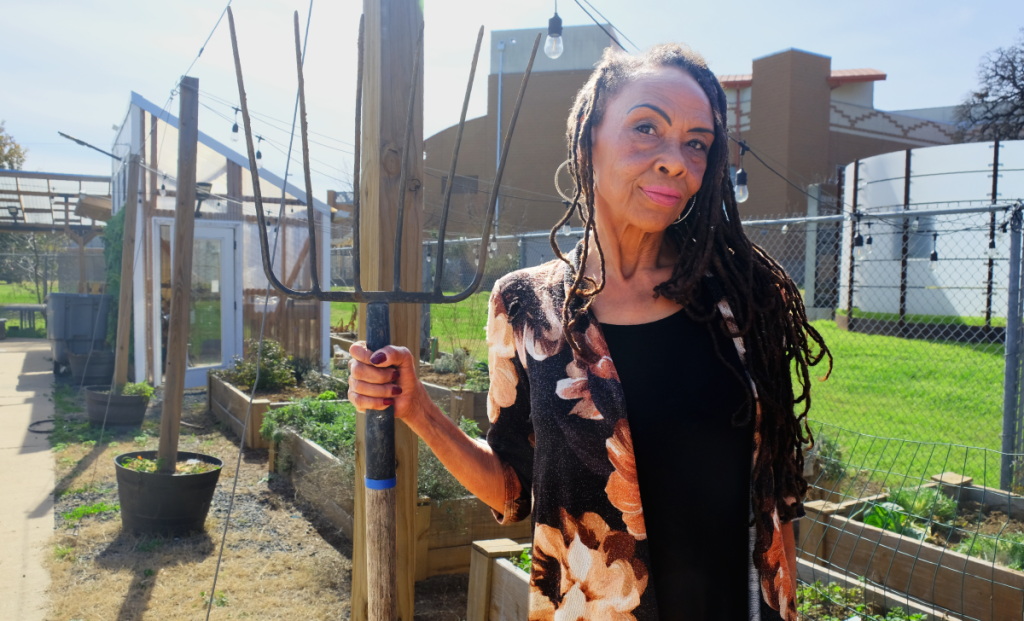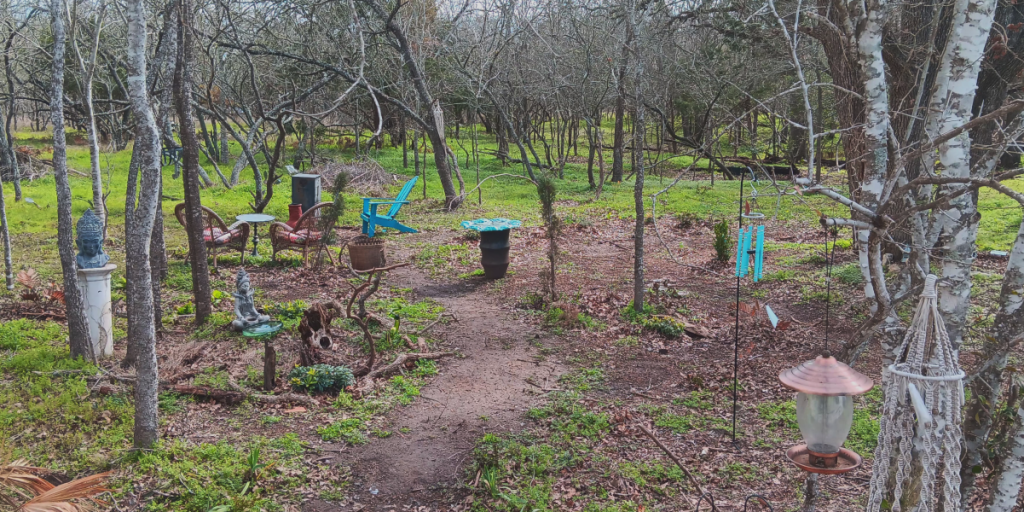Net-Zero Hero: Harvé Franks

I’m helping to make Austin Net-Zero by growing food and trees on private and public properties to fight hunger and create a more abundant earth.
The African American community in Austin has a long-standing relationship with the land. Following emancipation in the 1860s, Black farmers created “Freedom Colonies” — self-sufficient communities where infertile land was transformed into circular economies, supplying their communities with a diverse selection of food. While Freedom Colonies would not survive the structural racism of Austin’s 1928 Master Plan, the legacy of these farmers is still felt today.
Gardener Harvé Franks, our newest Net-Zero Hero, is working to honor and celebrate this history. Inspired by the generations who came before her, Harvé is working to elevate the stories of Austin’s African American gardeners, farmers, and changemakers. Harvé serves as the first Community Garden Coordinator at the City of Austin’s George Washington Carver Museum and Cultural Center, where she works with community members to share the stories of Austin’s Black community and tend to growth — both of the land and of her people.
We met with Harvé at the Carver Museum to talk about her personal family legacy, what inspired her interest in gardening, and her hopes for the future.
What inspired you to take action?
I was lucky enough to grow up with both a rural and urban perspective. My family was based in Austin, and we spent weekends and summers in the surrounding agricultural communities. I was introduced to gardening at an early age and, as a child, was taught farming by my grandparents — who passed down the knowledge from their grandparents before them.
Growing up between the city and the country broadened my horticultural palate. I went on to study Fine Art in college and fell in love with the Renaissance Gardens of Europe. I felt inspired to one day come home and create the gardens that I fell in love with.
I had watched The Central Texas Gardener for years and was greatly inspired by Ted Fisher, the Travis County Extension Agent. Twenty years ago, I took his course to become a Master Gardener. It was the last course he taught, and at the time, I was one of two of the first African American Master Gardeners in Austin. Last year, I was lucky enough to get featured on the show. It was a full-circle moment!
Once I became a Master Gardener, I began to study every form of horticulture that I could: Mediterranean Gardens, English Gardens, Southwest Gardens, the list goes on…

Harvé speaks to us while pulling weeds from the Children’s Garden at the Carver Museum.
When I found my way back to Austin after college, it was my dream to beautify East Austin. In 2021, I became the Gardens Coordinator with the George Washington Carver Museum and Cultural Center. I oversee the Carver’s Sunken Garden — which serves as a test garden to demonstrate the wonderful possibilities that exist in gardening. The garden is built in a concrete pool in the middle of the city that had been long forgotten.
But with a seed and a dream, new life can sprout.
How did you do it?
When the wonderful curator of the Carver Museum, Carre Adams, interviewed me for my current position, it was a dream opportunity. It meant I got to come back to my community and make a difference through horticulture. When I began work on the gardens, I knew I needed to start from the bottom and work my way up.
With good soil and filled beds, I began to plant seeds and buy seedlings. With the start of summer programming, we suddenly had youth who could work daily alongside me in the garden. I had the opportunity to look at gardening through the eyes of children.

.png)
Top: Harvé walks along the poolside garden at the Carver Museum. Below: The gardens in full bloom. The left plot has snapdragons, purple mustard, and Asian greens. The one on the right features Swiss chard and spearmint.
I started teaching horticulture to anyone interested: youth, adults, seniors. I knew I had received my calling. We now offer many ways to engage in this work: hands-on learning, horticultural lectures, indoor plant classes for seniors, community dig-ins — all of these activities make it possible for many hands and hearts to come together and grow.
What’s been most rewarding about getting involved in this way?
The most rewarding part is seeing how gardening can bring so many people of different ages, races, and socioeconomic backgrounds together. The gardens show me daily that planting a tiny seed can make a big impact.

Harvé sits in a rocker within the decommissioned pool where she shares the story of George Washington Carver, a farmer himself, with visiting school groups.
What’s been the toughest part?
The toughest part has been trying to find the time to accomplish all I hope to do in the gardens and with my community. After seeing my community literally become dispersed throughout Austin and the surrounding cities, I am working to create a Horticultural Outreach Program to promote the Carver Museum and its programming to members of our community who may not have had the opportunity to visit. My goal is to go into schools, community centers, and neighborhoods to help do beautification projects and help them learn about the amazing cultural legacy of African Americans in the Austin community.

An American Gothic revisited: Harvé poses in the gardens at the Carver Museum.
I want to work with our community to help educate the public on water conservation and gardening practices that support a better climate. There is so much I want to do that it can feel overwhelming at times, especially because the goal is so important to me.
We’ve read that your grandparents had a farm in the St. John Freedmen's Colony in Austin that provided produce to a family-owned restaurant on Airport Boulevard. Can you talk about your generational connection to working the land in this way? What does it mean to you?
I spent my summers harvesting peas, potatoes, corn, and other produce at my grandparents' farm. I would see it end up on the tables of my grandmother’s café. When the concept of ‘farm-to-table’ started being spoken about, I knew it was what I had grown up learning.
I wanted to incorporate what I had learned into a summer camp curriculum. I decided to teach a Farm-to-Table Summer Camp. It was very rewarding to teach children how to plant seeds, grow seedlings, and harvest veggies and herbs. We would bring our produce into the Culinary Kitchen and prepare a meal together — my hope is that it would lead to a lifelong love of gardening.
For me, as a gardener, to watch a kid say, “I don't like tomatoes or veggies,” but then totally devour a salad made of them was the most rewarding experience ever. I was able to pass on my childhood love of fresh food that had brought me back to the garden. Now, when I tell the children that they are the future of the planet, I can explain why.
I’ve since inherited my grandfather’s old peanut farm. I’m working on turning it into a full food forest. I hope to host community events and gatherings there to share more about the land and its legacy and help more people connect to their food.

A photo from Harvé’s developing food forest.
As a born-and-bred Austinite, is there something you wish more people knew about the history of Austin, especially as it relates to farming and gardening?
I want to tell you about the hard-working community members of Austin, like my Aunt Lucille.
Lucille had a home in East Austin. Her house and yard were her pride and joy. She didn’t have any children. Aunt Lucille was a professional baker at a glamorous hotel, and she would make me the most exquisite desserts and pastries.
But the sweetest part about her was her yard.
She loved gardening and decorated her yard in the English formal garden style. She had beautiful boxwoods that framed her entire property. They were always exquisitely manicured. Aunt Lucille grew long-stemmed red roses. She kept her lawn green and pristine.
As a child, I spent hours playing under the giant ligustrum that smelt like apples. In her backyard, she had fig trees, plum trees, and peach trees.
Aunt Lucille wore matching hats, gloves, and purses, and so did I. She is the reason I still long for tea parties and formal hats.
So, yes. I want to tell the stories of East Austin — of the beautiful neighborhoods where African American families took pride in their yards and were able to foster their own gardening styles.
Aunt Lucille is the reason I’m now creating a Meditteranean courtyard garden and food forest at my grandfather’s farm. She is the reason why I garden outside the lines — why I plant olive trees and palm trees in Central Texas and dare to dream.

Harvé stands outside the George Washington Carver Museum and Cultural Center in East Austin.
Is there a book, documentary, or other piece of media you would recommend for folks wanting to learn more about these topics?
As I mentioned earlier, I have been inspired by PBS and gardening shows like The Central Texas Gardener and The Victory Garden. Now, I hope to have my own horticultural gardening show one day: Harve’s Harvest.
I spent many years buying so many books on different horticultural topics. I suggest going to bookstores to find out what areas you are interested in and then studying those areas.
I’m now a big fan of Pinterest and YouTube. I find much horticultural and motivational inspiration there, as well as tutorials.
In 2023, I took up the topic of food sustainability and food forestry, partly inspired by the Austin-Travis County food planning efforts. I spend every hour — when not at the office — learning as much as possible on the many topics of study.
I have saved a lot of money studying advanced topics on the internet at my own pace instead of buying books. I was even able to create boards with ideas for the garden designs I wanted to create.
What advice do you have for others?
My advice to others is to try something new.
Grow something — it is inspiring to watch something bloom, grow, or provide food. Take a class, start a community garden, or decorate your porch or patio with plants. Connecting with plants is a great way to add beauty to your environment while also engaging in a healing activity. If there is nowhere for you to garden, bring a few houseplants or herbs into the kitchen.
I also encourage people to find other ways to connect with nature. It can help lift your spirit and bring clarity. Walking, hiking, or camping — any activity that helps us get into nature is great!

You can join Harvé in supporting the George Washington Carver Museum & Cultural Center by volunteering. Curious to know more about Austin/Travis County’s food planning process? Check out what we’ve been hearing from community members. To learn more about Austin's net-zero goal and the actions you can take to support a greener community, view the Austin Climate Equity Plan.
Share your Net-Zero contributions with us on X (Twitter) or Facebook using #NetZeroHero. If you know a Net-Zero Hero (or heroes!) who should be recognized for their efforts, send your nomination to sustainability@austintexas.gov.
